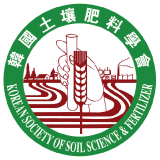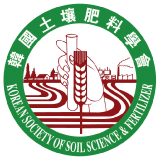-
Original research article
- Evaluation of agro-active metabolite production in the co-culture of Bacillus subtilis PE7 and Bacillus amyloliquefaciens N3S
- Chaw Ei Htwe Maung, Dae Seok Choi, Seong Eun Han, Kil Yong Kim
- Bacterial antagonists have gained great attention for their dual roles in plant growth promotion and disease control to reduce extensive use of …
- Bacterial antagonists have gained great attention for their dual roles in plant growth promotion and disease control to reduce extensive use of agrochemicals in sustainable agriculture. This study demonstrates the mutualistic growth of Bacillus subtilis PE7 and Bacillus amyloliquefaciens N3S in a co-culture system and their production of agro-active substances including indole-3-acetic acid (IAA) and antifungal metabolites compared with their corresponding monocultures. Although a cooperative growth of two Bacillus strains was observed, IAA production in the co-culture was lower than those in the monocultures. The culture filtrates (CFs) of strain N3S monoculture showed the highest inhibitory action on mycelial growth of Sclerotinia sclerotiorum. In addition, the antifungal activity of the CFs of the co-culture was stronger than that of strain PE7 monoculture. Treatment of S. sclerotiorum with the CFs of the monocultures and co-culture induced the severe distortions in the hyphal morphology. The cooperative growth as well as metabolite production of two Bacillus species in the co-culture highlights the potential of bacterial consortium for the development of effective biofertilizer and biofungicide in green agriculture. Different levels of growth inhibition of S. sclerotiorum caused by different culture filtrate concentrations of 3- and 5-day-old monocultures and co-culture of two Bacillus species - COLLAPSE
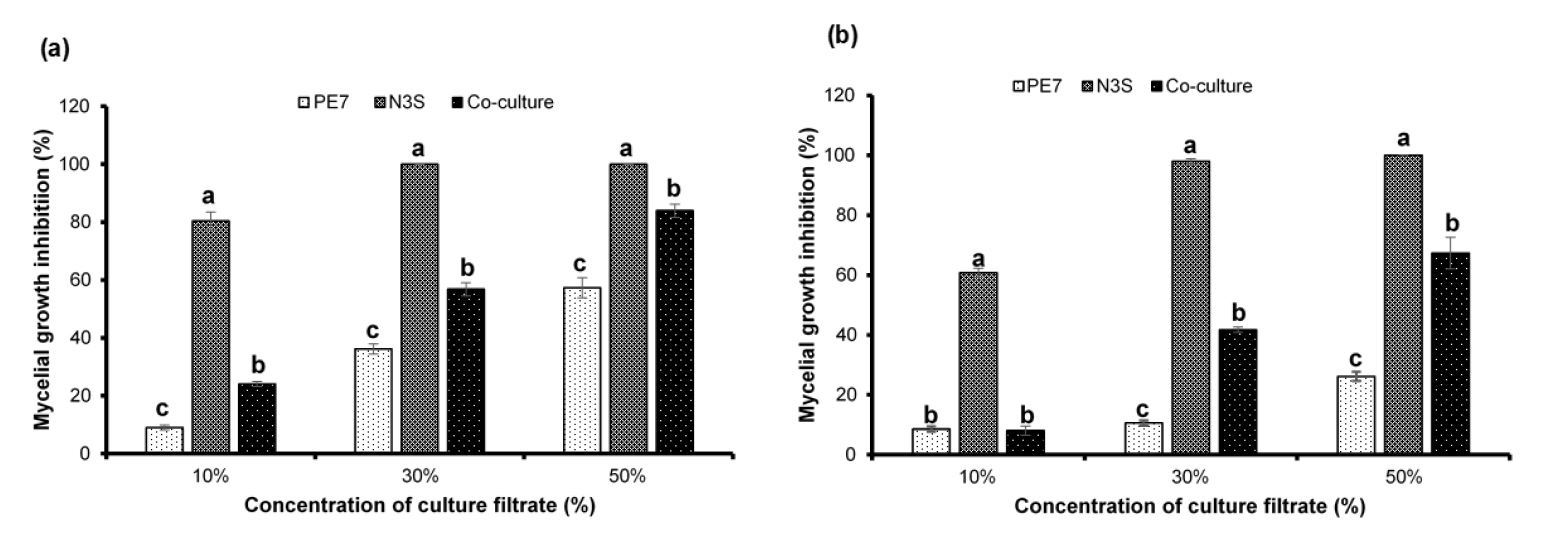
-
Original research article
- Effects of treatment with iron-based precipitate on the long-term leaching of nitrogen and phosphorus from livestock manure compost
- So Young Park, Su Chan Yang, Won Hyun Ji
- This study evaluated the applicability of iron-based precipitate (IBP), primarily composed of ferric hydroxide, as a stabilizing agent to reduce the leaching …
- This study evaluated the applicability of iron-based precipitate (IBP), primarily composed of ferric hydroxide, as a stabilizing agent to reduce the leaching of nitrogen (T-N) and phosphorus (T-P) from livestock manure compost. The mineralogical properties of IBP include an amorphous structure with a high Fe2O3 content (71.7%), a specific surface area of 266.17 m2 g-1, and mesopores with an average pore size of 3.93 nm. Results from the toxicity characteristic leaching procedure (TCLP) and synthetic precipitation leaching procedure (SPLP) tests indicated a low environmental risk, showing undetectable or minimal concentrations of heavy metals, T-N, and T-P. Column experiments were conducted using cow and pig manure composts amended with 5wt% and 10wt% IBP. A synthetic acid rain solution, based on the SPLP method, was continuously applied for five years to simulate rainfall conditions. The results demonstrated that the addition of IBP generally reduced the leaching concentrations of both T-N and T-P. In pig manure compost, T-N was reduced by up to 11.1% and T-P by 47.9% with the 10 wt% IBP addition. On the other hand, cow manure compost exhibited a relatively lower reduction efficiency. These findings were consistent with previous batch test results, particularly for phosphorus stabilization. Overall, this study demonstrates that iron-based precipitate is effective in reducing the leaching of nutrients (N and P) from livestock manure compost and poses minimal environmental risk. Therefore, IBP is expected to be utilized as an eco-friendly stabilization strategy to mitigate agricultural non-point source pollution and prevent eutrophication in adjacent water systems. Five-year nitrogen and phosphorus leaching concentrations and reduction efficiency of livestock manure compost with iron-based precipitates. Livestock manure compost IBP1 mix ratio (wt%) Total leaching concentration over a five-year period (%) Reduction efficiency (%) T-N RSD4 T-P RSD4 T-N T-P CMC2 0wt% 1.41 6.21 0.37 5.71 - - 5wt% 1.39 2.57 0.35 4.35 1.4 5.1 10wt% 1.38 4.75 0.30 1.29 2.3 19.3 PMC3 0wt% 1.28 5.30 0.35 4.74 - - 5wt% 1.17 7.93 0.22 1.17 8.1 36.0 10wt% 1.13 10.08 0.18 2.65 11.1 47.9 1IBP, iron-based precipitate; 2CMC, cow manure compost; 3PMC, pig manure compost; 4RSD (%), relative standard deviation. - COLLAPSE
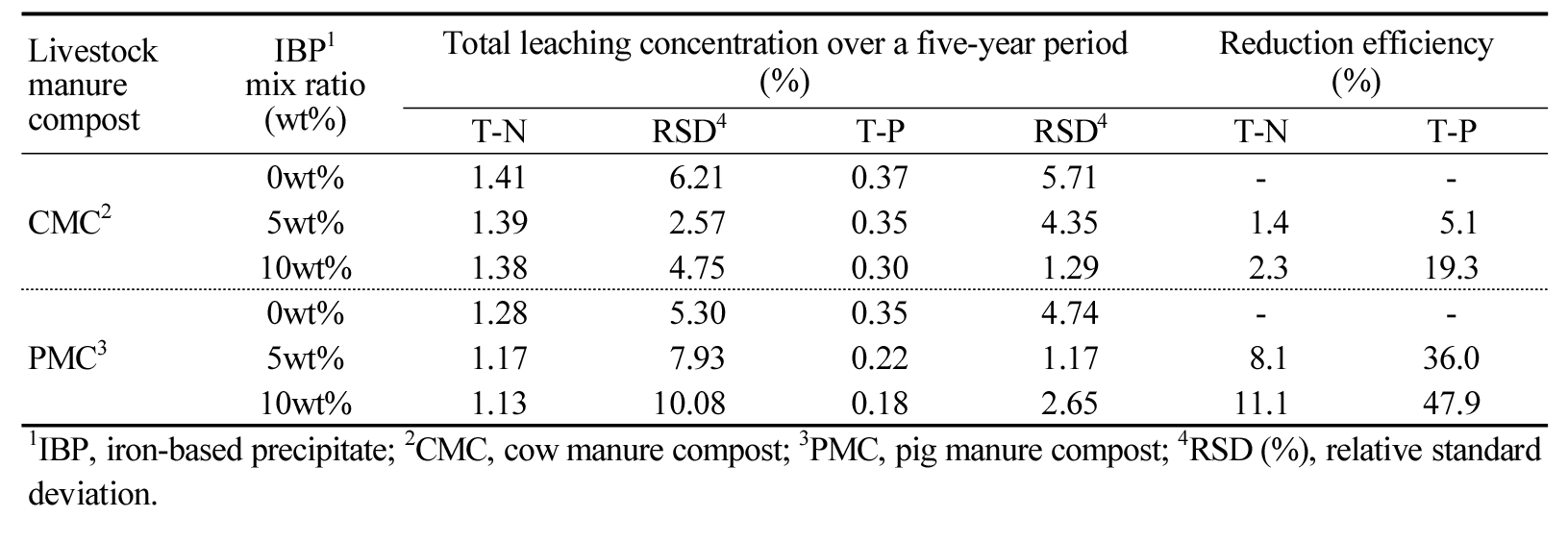
-
Original research article
- A Simple field volumetric method for estimating soil bulk density and three-phase composition
- Seok-Soon Jeong, Tae-Yol Ko, Kang-Ho Jung, Jung-Hwan Yoon, Jae E. Yang, Hyuck-Soo Kim, Byung-Jun Park, Hee-Rae Cho, Kyung-Hwa Han, Wi-Young Lee, Yong-Seon Zhang
- Soil bulk density and three-phase composition are critical physical indicators for evaluating soil health and supporting sustainable soil management. In-situ measurement of …
- Soil bulk density and three-phase composition are critical physical indicators for evaluating soil health and supporting sustainable soil management. In-situ measurement of these properties helps diagnose field-related constraints affecting productivity, such as poor drainage, compaction, aeration, and drought stress. While the oven-dry gravimetric method (OG) is the standard for measuring these parameters, its application in the field is constrained by time and equipment requirements. To address this, a simple field volumetric method (FV) was developed and validated through comparative analysis with the OG method. Both methods were applied to 38 soil samples to measure bulk density and three-phase composition (solid, liquid, and gaseous). Agreement was assessed using linear regression, coefficient of variation (CV), Bland–Altman plots, and Cronbach’s alpha. Regression results showed significant (P < 0.01) correlations between methods, with r2 values of 0.89 - 0.91 and standard errors ranging from 0.05 to 3.92. The solid phase showed the highest compatibility among the three-phase composition. CVs ranged from 4.7 - 17.3 for FV and 3.5 - 15.2 for OG, but differences were not statistically significant. Most values fell within the 95% limits of agreement in Bland–Altman analysis. Cronbach’s alpha values higher than 0.7 (0.95 - 0.97) indicated excellent internal consistency across parameters. These findings demonstrate that the FV method provides a reliable and efficient alternative for rapid field assessment of soil bulk density and three-phase composition. Linear regression models for bulk density (a) and the three-phase composition (b-d). - COLLAPSE
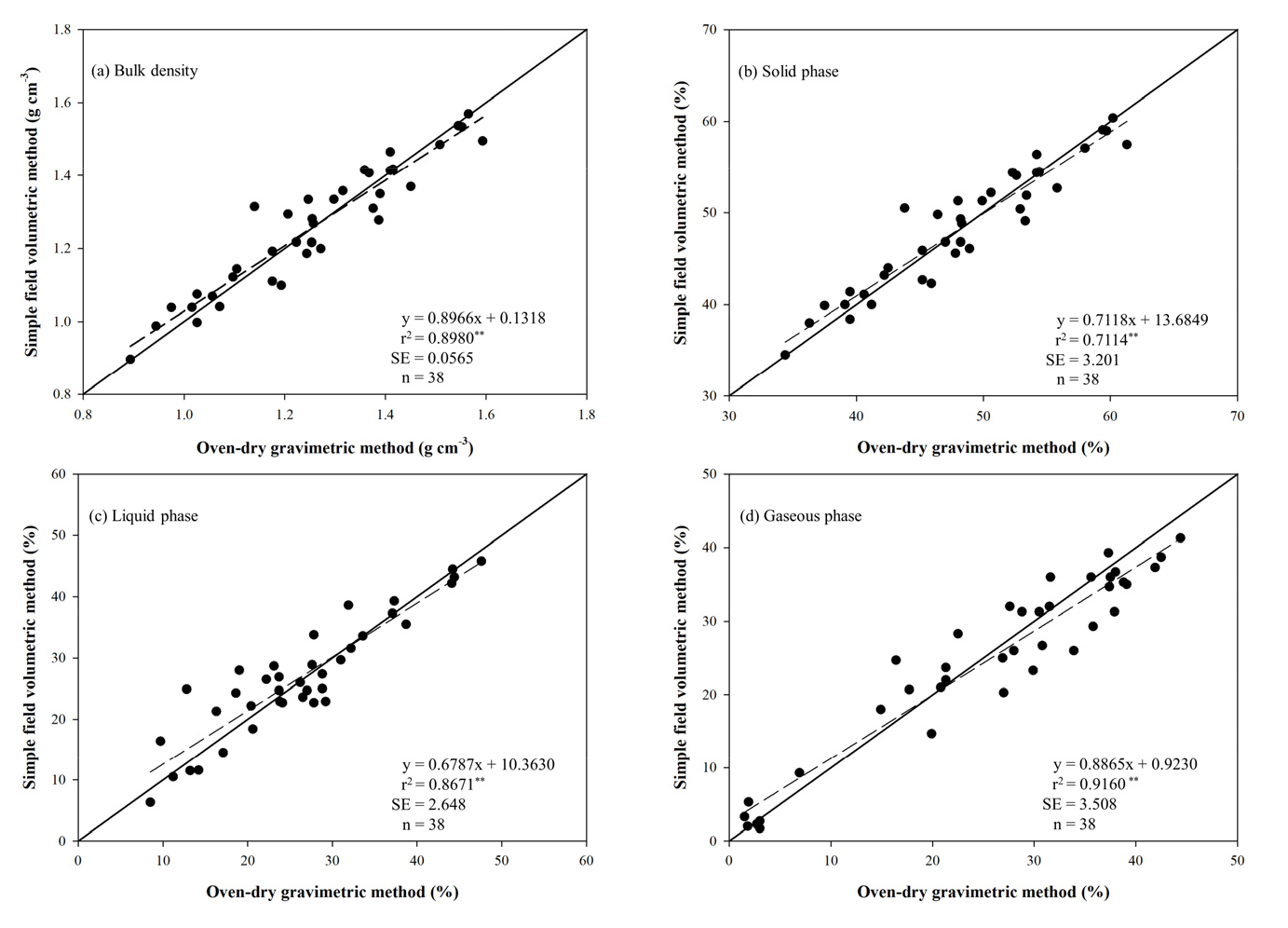
-
Original research article
- Evaluation of the feasibility of fertilizer deep-placement for N2O mitigation and soil fertility improvement in rice paddies of Chungnam provinces
- Yun-Gu Kang, Ji-Hoon Kim, Jun-Yeong Lee, Jiwon Choi, Jun-Ho Kim, Taek-Keun Oh
- Nitrogen (N) losses occur primarily through N fertilization to the agricultural soil surface, while their efficiencies varied from various N fertilization strategies, …
- Nitrogen (N) losses occur primarily through N fertilization to the agricultural soil surface, while their efficiencies varied from various N fertilization strategies, including types, amounts, and fertilization methods. This field-based study aimed to evaluate the individual or combined effects of fertilizer deep-placement (FDP), which input N fertilizers to a soil depth of 20 - 30 cm, technique with 20% reduced N fertilization on N2O emissions and soil chemical properties in irrigated paddy soils. For assessing their N2O reduction efficiency, treatment groups were divided as follows: conventional N fertilization (control), FDP, and FDP application with 20% reduced N fertilization (FDPrf). Soil total nitrogen and NH4+ concentrations were increased by the FDP application, while the decrease in soil NO3- content was revealed. Additionally, the individual FDP amendment led significantly to decrease the soil organic matter content, resulting from the lowest value at 17.6 g kg-1. However, the co-application of FDP technique and 20% reduced N narrowed not only decreasing FDP-induced variations but also enhancing the availability of soil phosphorus and calcium compared to the conventional fertilization method. The highest daily N2O emission was observed in the control treatment (87.2 g ha-1 day-1), while FDP and FDPrf treatments reduced this to 64.7 g ha-1 day-1 and 51.3 g ha-1 day-1, respectively. In addition, cumulative N2O emission was reduced by 27% with the FDP application, while statistically significant differences were not observed between FDP and FDPrf treatments. These findings suggest that the FDP technique effectively mitigates the N2O emissions by N stabilizing (in the form of NH4+) and maintaining favorable soil environments. However, for developing FDP-based sustainable and climate- resilient agricultural approaches, the findings of our study suggest the FDP application with additional organic matter supply. Mechanisms for nitrous oxide (N2O) generation and N2O mitigation process by application of fertilizer deep-placement from irrigated paddy soils. - COLLAPSE
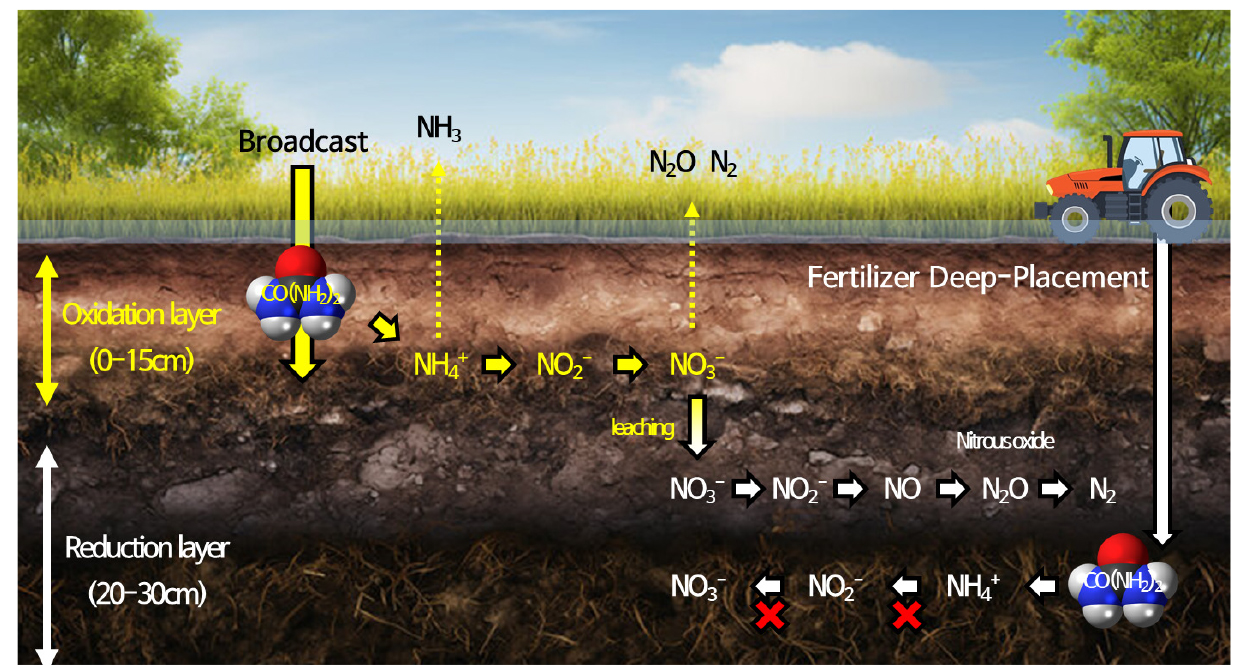
-
Original research article
- Machine learning approach for quantifying methane emissions from a flooded rice paddy in Chungcheong province
- Yun-Gu Kang, Jun-Yeong Lee, Ji-Hoon Kim, Jiwon Choi, Jun-Ho Kim, Jin-Hyuk Chun, Taek-Keun Oh
- Machine learning (ML)-based estimation of methane (CH4) emissions is essential to effectively assess the impacts of rice production and respond …
- Machine learning (ML)-based estimation of methane (CH4) emissions is essential to effectively assess the impacts of rice production and respond to climate change. This approach not only requires less labor and costs than field-based study, but also entails high reproducibility and applicability. However, optimal ML algorithms and combination of environmental covariates for forecasting CH4 emissions are still lacking. Hence, the goals of this study were (1) to evaluate the regression performance of three ML algorithms (i.e., multiple linear regression, ridge regression, and random-forest) and (2) to assess the relative influence of each environmental factor within the predictive model for CH4 emissions. The environmental covariates, which obtained from rice paddy field at Daejeon, South Korea in 2024, classified as followed: climatic factors (i.e., atmospheric, soil, and water temperatures and precipitation), fertilization method (i.e., quantity of nitrogen fertilization and fertilizer deep-placement application), and soil properties (i.e., oxidation-reduction potential and soil drainage). Our predictive model based on the random-forest algorithm outperformed than the linear-based ML algorithms. The random-forest algorithm achieved the highest reliability of 86.1%, and the mean value of the K-Fold cross-validation was 83.0%. The relative influence of each parameter was exhibited to be high in the order of atmospheric temperature (0.49), soil temperature (0.27), quantity of nitrogen fertilization (0.20), fertilizer deep-placement (0.17), and soil drainage (0.17). These findings revealed the requirement of explanation capacity for non-linear relationship in forecasting the CH4 emissions, and need for collecting various environmental factors related to rice production. (A) Correlation between environmental factors and methane (CH4) emissions and (B) Comparison of the model performance with variations in the key features. - COLLAPSE
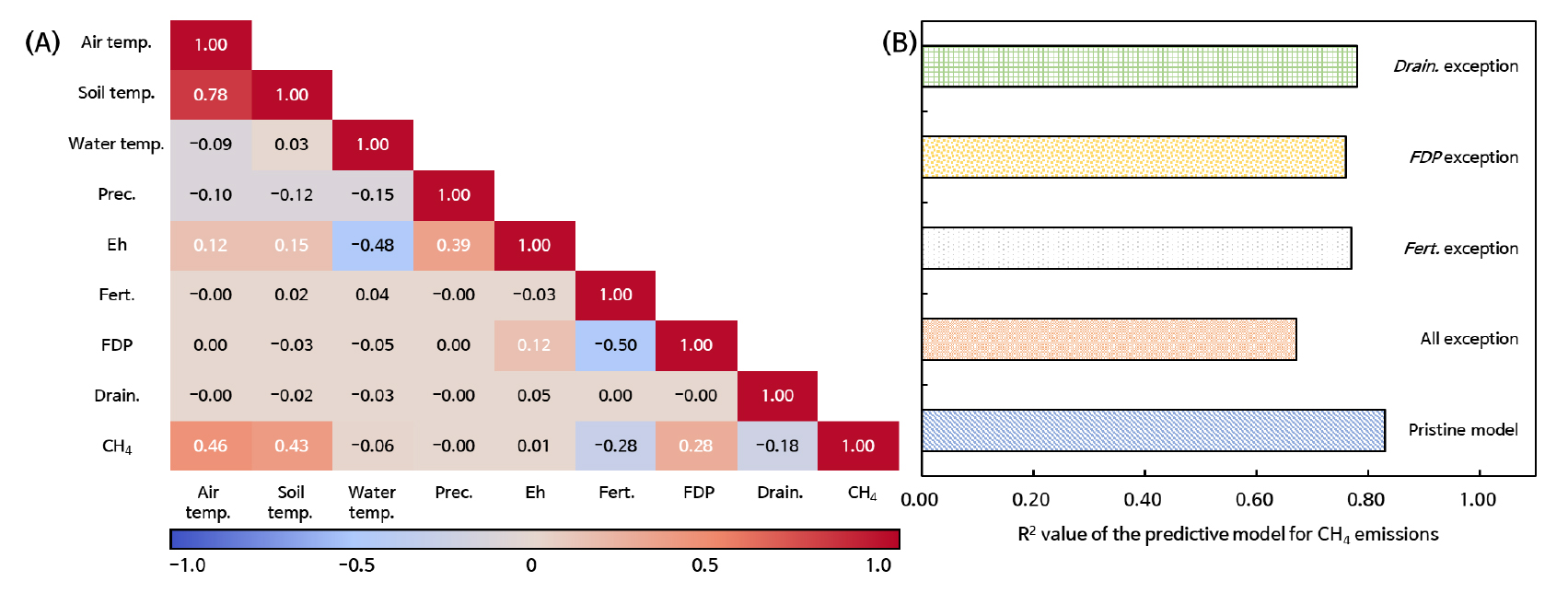
-
Original research article
- Mitigating continuous cropping stress in greenhouse lettuce cultivation using organic and inorganic soil amendments
- Hyo-Jung Choi, Jae-Heon Yoo, Mi-Jeong Uhm, So-Ra Choi
- In greenhouse cultivation systems, repeated and intensive cropping often lead to soil problems such as salt accumulation, organic matter depletion, deterioration of …
- In greenhouse cultivation systems, repeated and intensive cropping often lead to soil problems such as salt accumulation, organic matter depletion, deterioration of soil physical properties, and increased pest and disease incidence, resulting in reduced crop growth and yield. This study was conducted to mitigate continuous cropping obstacles and improve soil conditions by applying various organic and inorganic soil amendments, including biochar (BC), rice husks (RH), rice straw (RS), and weathered granite soil (MS). The experiment was carried out in a greenhouse lettuce (Lactuca sativa L.) field in Bibong-myeon, Wanju-gun, Jeollabuk-do, Korea, where lettuce had been continuously cultivated for more than 10 years. Soil amendments were applied four weeks before transplanting at rates of 0.2, 2, and 2 ton 10a-1 for BC, RH, and RS, respectively, and 35 ton 10a-1 for MS. The effects of each amendment on soil physicochemical properties, crop growth, and disease incidence were evaluated. BC and RH treatments significantly reduced soil bulk density to 0.9 Mg m-3 compared with the control (1.3 Mg m-3, p < 0.05), increased effective soil depth up to 27 cm, and decreased electrical conductivity from 5.3 to 1.4 dS m-1. In terms of lettuce growth, the number of leaves per plant (12.5 and 12.3, respectively) and yields (5,037 and 5,061 kg 10a-1, respectively) in BC and RH treatments were significantly higher than those of the control (1,941 kg 10a-1), representing approximately a 2.6-fold increase. In contrast, the MS treatment exhibited the highest bulk density (1.2 Mg m-3) and the lowest organic matter content (28.0 g kg-1), indicating minimal improvement in soil physical properties. Additionally, BC treatment effectively suppressed soil nematode density (31 individuals per 100 g soil) and reduced fusarium wilt incidence. While RH and RS treatments slightly increased nematode populations, they positively influenced root development (p < 0.05). These results suggest that biochar and rice husks are effective amendments for mitigating continuous cropping stress in greenhouse lettuce cultivation, and that long-term studies are required to establish optimal application strategies for sustainable soil management. Crop growth and yield responses at 50 days after transplanting under different soil amendment treatments. Treatments1 Plant height (cm) Number of leaves (ea) Leaf length (cm) Leaf width (cm) Leaf color (SPAD) Root fresh weight (g plant-1) Root length (cm) Yield (kg 10a-1) Index (%) relative to control CON 19.0 bc2 11.5 b 13.5 b 8.9 b 40 a 8.7 c 10.7 b 1,941 b 100 BC 22.2 ab 12.5 a 15.6 a 11.1 a 39 a 13.9 a 15.0 a 5,037 a 260 RH 22.4 a 12.3 a 16.0 a 11.0 a 38 ab 13.6 a 13.3 a 5,061 a 261 RS 21.7 a 11.5 b 15.5 a 10.5 a 37 b 12.5 ab 13.3 a 4,507 a 232 MS 19.4 c 9.3 c 12.9 b 9.0 b 38 ab 9.6 bc 10.8 b 2,204 b 114 Effect Probability > F Treatment * *** ** *** 0.0894 ** ** *** - 1CON, no treatment as control; BC, application with biochar; RH, application with the rice husk; RS, application with rice straw; MS, application with weathered granite soil. 2Mean values (n = 3), with different lowercase letters indicating significant difference at p < 0.05 by Duncan’s multiple range test. - COLLAPSE
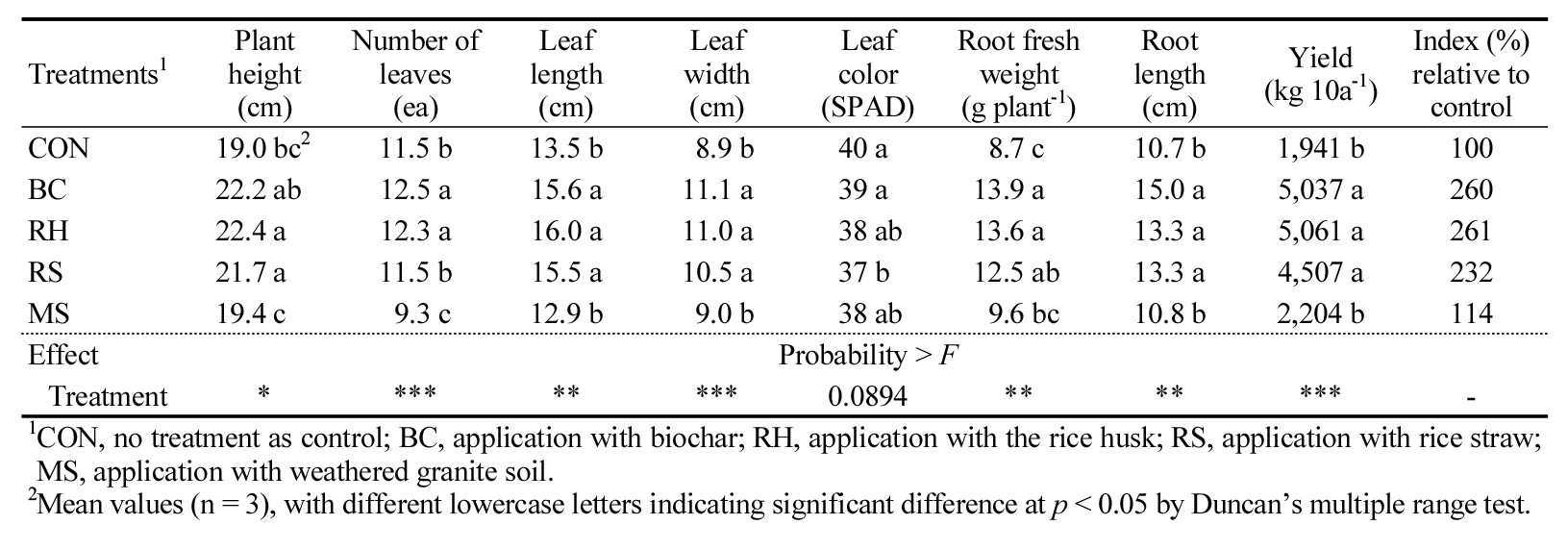
-
Original research article
- Slope construction increased surface drainage but caused drought stress on soybean growth at Saemangeum reclaimed tideland
- Seung-Beom Lee, Yerim Oh, Kwang-Seung Lee, Kyung-Hwa Han, Jin-Hyeob Kwak
- Reclaimed tidelands (RTLs) in Korea were originally developed for rice cultivation; however, converting paddy to upland field is encouraged to improve grain …
- Reclaimed tidelands (RTLs) in Korea were originally developed for rice cultivation; however, converting paddy to upland field is encouraged to improve grain self-sufficiency. However, due to poor drainage, high salinity, and low nutrient availability, cultivating upland crops in RTLs have many challenges. Furthermore, frequent extreme weather events, such as precipitation, heatwaves, and droughts, uncertainty of cultivation management is increasing. Therefore, this study was conducted to evaluate the effect of slope construction on improving drainage through soil water content, and to analyze the effects of drought on soil water and soybean (Glycine max L. Merr.) growth in sloped and flat fields. Slope construction, in combination with high saturated hydraulic conductivity (0.07 cm hr-1) and surface drainage, led to a rapid decrease in soil water content after rainfall, which is benefit to reduce excess moisture injury for soybean during heavy rain season. However, after monsoon season, low precipitation caused soil water content to drop below 10%. Furthermore, prolonged high temperature from July to September, which includes flowering and pod-filling stages, caused sterility of pods and reduced overall yield. Such yield reduction was more prominent in sloped plot due to improved drainage efficiency. This study highlights the need for effective climate-resilient water management strategies, including irrigation and drainage, to support sustainable soybean cultivation in reclaimed tidelands. Slope construction improved surface drainage but caused drought damage on soybean growth during flowering and pod-filling period in the Saemangeum reclaimed tideland. - COLLAPSE
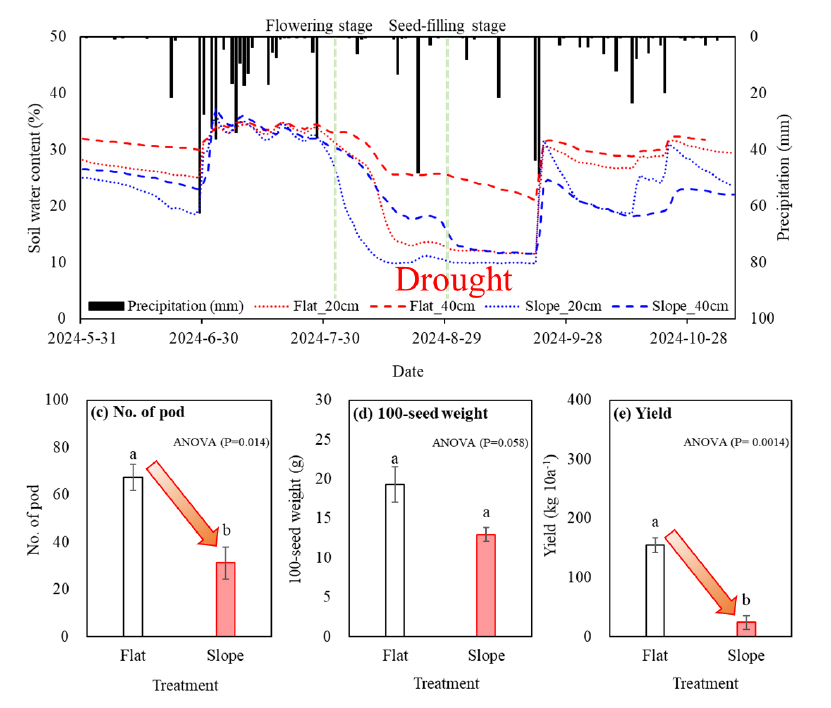
-
Original research article
- Distribution of soil microbial communities across agricultural land-Use types in Gyeong-buk Province
- Jeung-Woo Ko, Ji Won Kim, Hyong-Rack Sohn, San-Yeong Kim, Jung-Gi Ryu
- Soil microbial communities can vary greatly in their diversity and composition depending on land-use type, but there has been little research comparing …
- Soil microbial communities can vary greatly in their diversity and composition depending on land-use type, but there has been little research comparing different agricultural land-use types in Korea. This study evaluated the impact of different agricultural land-use types (paddy, upland, orchard, and greenhouse) on soil microbial communities in Gyeong-buk Province, South Korea. A total of 100 soil samples were collected and subjected to DNA sequencing targeting bacterial 16S rRNA genes and fungal ITS regions to assess microbial richness, diversity, and community composition. Alpha diversity analysis revealed that bacterial richness (Chao1, ACE) was higher in uplands and orchards, while paddy soils showed the highest bacterial and fungal diversity (Shannon, Inverse Simpson), indicating more balanced microbial communities. In contrast, greenhouses exhibited the lowest richness and evenness for both bacteria and fungi, likely due to intensive agricultural practices. Principal Component Analysis (PCA) and Principal Coordinates Analysis (PCoA) demonstrated distinct microbial community structures across land-use types, with bacterial communities showing clearer separation. PERMANOVA confirmed significant differences in community composition (bacteria R2 = 0.732; fungi R2 = 0.399; p < 0.001). At the phylum level, Proteobacteria, Actinobacteria, and Acidobacteria dominated bacterial communities, while Ascomycota and Mortierellomycota were predominant in fungi. These patterns reflect the influence of soil moisture, organic matter, and management practices on microbial structure. These results provide clear evidence that land-use type affects soil microbial diversity and composition. Diversity indices of soil microbial communities across agricultural land-use types in Gyeong buk Province. Land-use Richness index Diversity index Evenness index Chao1 Ace Shannon Inverse Simpson Shannon Evenness Simpson Evenness Bacteria1 Upland 4,935 ± 1,081 a 5,114 ± 1,099 a 6.7 ± 0.45 a 234.3 ± 104.56 b 0.81 ± 0.037 b 0.06 ± 0.020 b Orchard 4,693 ± 916 a 5,284 ± 1,127 a 6.6 ± 0.59 a 185.9 ± 89.88 b 0.82 ± 0.059 b 0.06 ± 0.025 b Paddy 4,064 ± 820 b 5,158 ± 1,077 a 6.8 ± 0.40 a 309.9 ± 76.61 a 0.87 ± 0.008 a 0.13 ± 0.026 a Greenhouse 3,018 ± 797 c 3,213 ± 855 b 5.8 ± 0.71 b 92.6 ± 77.23 c 0.75 ± 0.070 c 0.04 ± 0.026 c Fungi2 Upland 507 ± 80 c 501 ± 77 c 3.8 ± 0.49 b 19.5 ± 9.39 a 0.61 ± 0.074 a 0.04 ± 0.022 a Orchard 750 ± 252 b 810 ± 271 b 3.7 ± 0.64 b 15.9 ± 9.68 ab 0.59 ± 0.070 ab 0.03 ± 0.011 b Paddy 967 ± 157 a 987 ± 163 a 4.1 ± 0.34 a 19.2 ± 9.59 a 0.62 ± 0.045 a 0.03 ± 0.012 b Greenhouse 527 ± 213 c 574 ± 214 c 3.2 ± 0.85 c 12.8 ± 9.99 b 0.54 ± 0.111 b 0.03 ± 0.022 ab Values with differ letters are significantly different according to Duncan’s multiple range test at p < 0.05. 1Data for bacterial community analysis, 2Data for fungal community analysis. Diversity indices of soil microbial communities across agricultural land-use types in Gyeong buk Province. - COLLAPSE
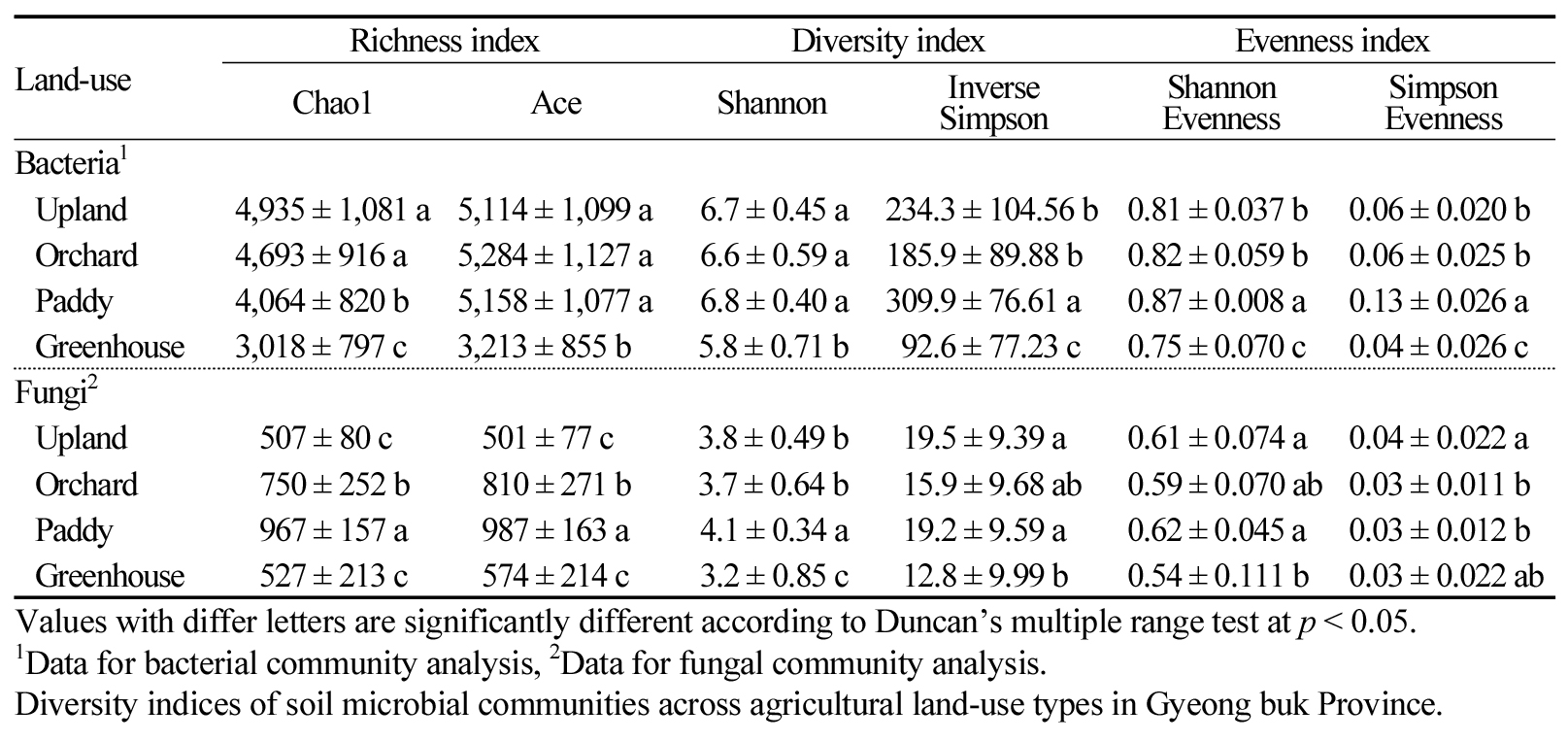
-
Short communication
- Correlation between fertilizer application, soil chemical properties and mineral nutrient contents in Forage Barley (Hordeum vulgare L.)
- Hee-Jeong Je, Hyeon-Ji Cho, Mi-Jin Lee, Young-min Jin, Young Han Lee, Yejin Lee
- Fertilizer use in forage barley production has a strong correlation with both soil chemical properties and the mineral nutrient contents of the …
- Fertilizer use in forage barley production has a strong correlation with both soil chemical properties and the mineral nutrient contents of the barley itself. However, there is still an incomplete understanding of the relative importance of different traits and how they interact to affect forage yield. We investigated 50 farms in Gyeongsang-do areas to assess correlations among fertilizer use, soil chemical properties, and nutrient uptake. The average fertilization rates for forage barley were N-P2O5-K2O = 18.9-4.1-10.4 kg 10a-1. Correlations were observed between NPK fertilization, soil organic matter, and the nutrient content of forage barley. The average rate of potassium fertilizer application showed a correlation with the nitrogen content and yield in forage barley. Soil EC, NO3-N and exchangeable K were correlated with the nitrogen and potassium contents in the forage barley. Based on these results, this study provides fertilizer recommendations for forage barley cultivation based on soil chemical properties and the nutrient uptake characteristics of the crop. By following these recommendations, farmers can contribute to the balanced management of soil nutrients and reduce excessive fertilizer input through the application of appropriate fertilizer rates. Correlation among fertilizer application rates, soil chemical properties and nutrient content of Forage Barley (Hordeum vulgare L.) (n = 50). N fert P fert K fert pH EC OM NO3-N T-N Avail. P2O5 Ex. K Ex. Ca Ex. Mg K/Ca+Mg Yield 0.143 0.216 0.369* -0.039 0.158 -0.047 -0.027 0.118 -0.012 0.170 -0.085 -0.119 0.211 Nutrient content N 0.007 0.074 0.291* -0.113 0.501* -0.217 0.434* -0.105 0.085 0.422* -0.046 0.163 0.050* P -0.056 0.082 0.174 -0.238 0.221 -0.012 0.209 0.194 0.205 0.006 -0.089 -0.065 0.036 K 0.132 0.098 0.240 0.109 0.535** -0.031 0.292* 0.067 0.182 0.626** 0.025 0.273 0.631** Ca -0.229 -0.231 0.242 -0.070 -0.393** 0.156 -0.205 0.208 -0.024 -0.191 -0.149 -0.091 -0.210 Mg 0.033 -0.045 -0.114 0.072 -0.121 0.026 0.051 -0.218 0.077 -0.093 -0.008 0.209 -0.032 Pearson correlation coefficients, *p < 0.05, **p < 0.01. - COLLAPSE

-
Short communication
- Long-term changes in physical properties of paddy soils in Gyeongnam province from 2015 to 2023
- Mi-jin Lee, Hee-jeong Je, Eun-Hee Han, Young-min Jin, Seung-Oh Hur
- Rice is the most important staple crop in South Korea, playing a central role in national food self-sufficiency and food security. To …
- Rice is the most important staple crop in South Korea, playing a central role in national food self-sufficiency and food security. To support stable and sustainable rice production, systematic monitoring of the physical condition of paddy soils is critical. This study investigated long-term changes in soil physical properties at 127 representative paddy field sites in Gyeongsangnam-do, with surveys conducted at four-year intervals from 2015 to 2023. The parameters included cultivated layer depth, bulk density, porosity, penetration resistance, and organic matter content. Topographic analysis showed that alluvial valley floors and alluvial fans accounted for 34% of the sites, while alluvial plains and marine plains accounted for 28% each. The results revealed a gradual deepening of the cultivated layer over time. Topsoil bulk density remained relatively stable, ranging from 1.14 to 1.19 Mg m-3, while subsoil bulk density increased steadily after 2015, reaching 1.52 Mg m-3 in 2023. Soil texture-specific analysis showed that sandy loam and silty clay loam subsoils exceeded critical threshold values for compaction, indicating the necessity for subsoil loosening and deep tillage interventions. Organic matter content peaked in 2015 and slightly declined thereafter, but consistently remained above 25 g kg-3. While organic matter application and the adoption of larger agricultural machinery may have contributed to the improvement of topsoil physical properties, repeated compaction in subsoil layers below tillage depth appears to have increased bulk density and hardness. Temporal analysis of physical properties on paddy soil (2015 - 2023). Year Soil layer PD1 (cm) Hardness (mm) BD2 (Mg m-3) OM3 (g kg-1) Porosity (%) Sand (%) Silt (%) Clay (%) 2015 TS4 15.2 (1.9) - 1.18 (0.12) 30.5 (9.4) 55.5 (0.8) 31.7 (18.8) 47.9 (13.4) 20.4 (8.0) SS5 - 21.0 (3.5) 1.46 (0.12) 20.5 (8.5) 44.7 (4.6) 33.2 (20.7) 46.3 (13.7) 20.5 (9.1) 2019 TS 20.2 (2.6) - 1.12 (0.14) 25.9 (7.5) 57.3 (5.1) 30.1 (20.7) 40.0 (14.0) 21.9 (9.6) SS - 21.1 (3.3) 1.49 (0.11) 16.7 (6.5) 43.5 (4.3) 31.5 (21.8) 46.5 (14.1) 22.0 (10.9) 2023 TS 21.4 (4.2) - 1.17 (0.13) 24.3 (8.3) 55.7 (4.8) 30.3 (20.6) 48.6 (12.9) 21.0 (9.3) SS - 22.8 (3.1) 1.52 (0.08) 15.2 (7.6) 42.6 (3.2) 30.2 (21.2) 48.2 (13.5) 21.6 (9.7) 1PD, plowing depth; 2BD, bulk density; 3OM, organic matter; 4TS, top soil; 5SS, sub-surface soil. Data are overall means (standard deviation) of survey points by topography in 2015, 2019, and 2023. - COLLAPSE
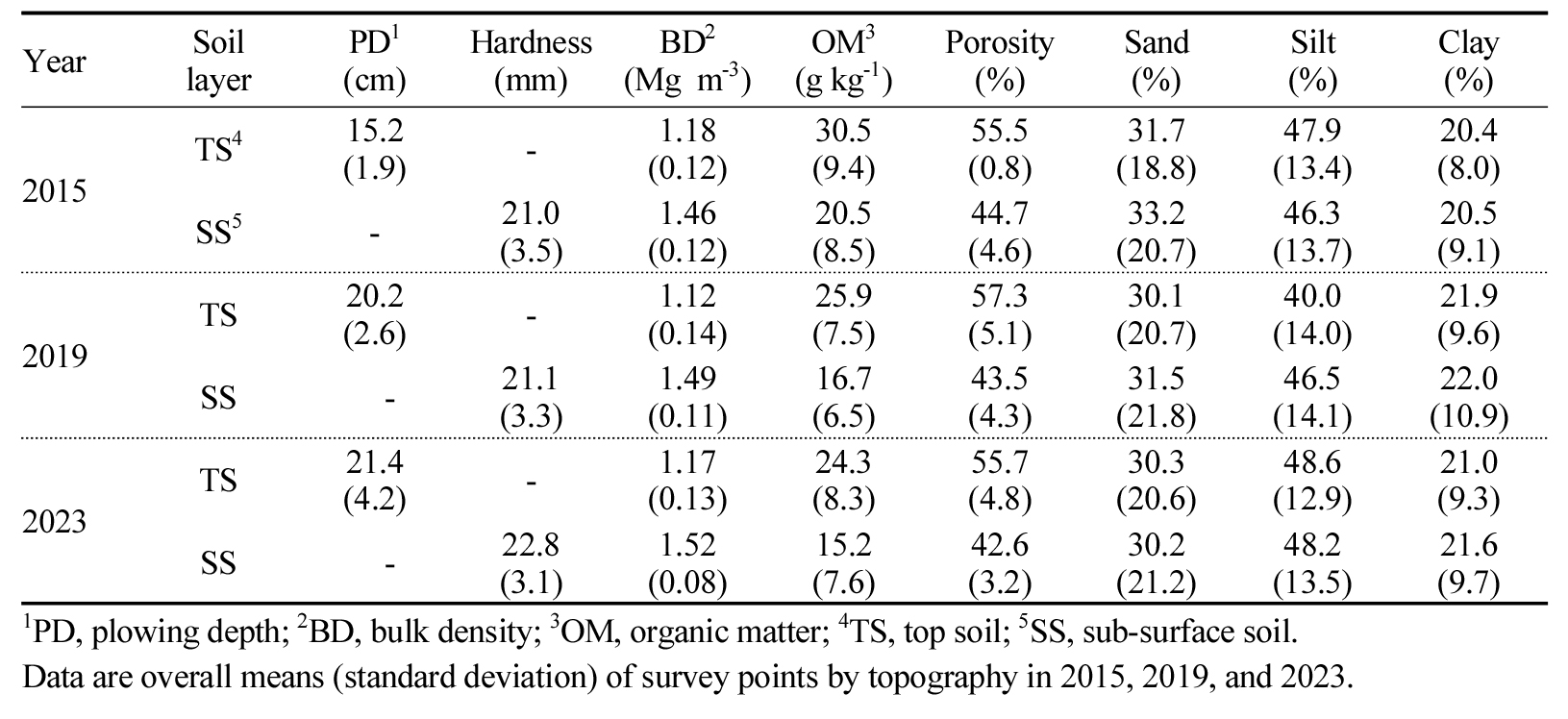
-
Short communication
- Water use efficiency of rice plants under elevated CO2 and warming in two years with contrasting weather conditions
- Nuri Baek, Seo-Woo Park, Eun-Seo Shin, Jiyu Lee, Hyun-Jin Park, Han-Yong Kim, Kwang-Sik Yoon, Woo-Jung Choi
- Water use efficiency (WUE) of rice (Oryza sativa L.) is a crucial factor to be considered in the management of water …
- Water use efficiency (WUE) of rice (Oryza sativa L.) is a crucial factor to be considered in the management of water resources in paddy systems. This study investigated the changes in the WUE under elevated CO2 concentration (e[CO2]) and air temperature (eTair) for two years with naturally varying weather conditions including solar radiation. Rice was cultivated under different [CO2]-Tair in 2019 - 2020, with higher solar radiation during rice growing period in 2019 (2079 MJ m-2) than in 2020 (1929 MJ m-2). The WUE was calculated by analyzing the stable carbon isotope ratio (δ13C) of rice plant tissues. e[CO2] consistently increased WUE by > 80% in both years regardless of Tair. Under any given [CO2] and Tair combination, the WUE of rice plants was consistently 10 - 34% higher in 2020 than in 2019, suggesting that rice under lower solar radiation utilized water more efficiently by reducing transpiration. These results suggest that the weather variability needs to be taken into account in the assessment of water resources for developing irrigation schemes under warming with e[CO2]. Elevated CO2 alone or combined with warming increases water use efficiency (WUE) of rice plants, and WUE further increases when solar radiation in limited due to decreased transpiration - COLLAPSE
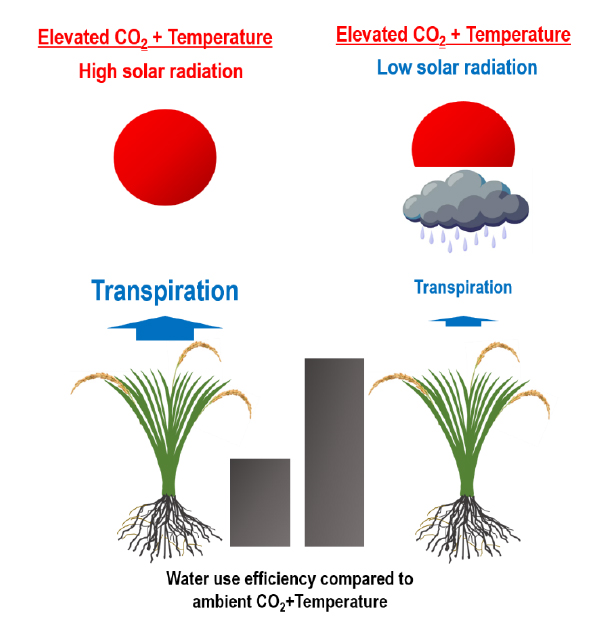
-
Short communication
- Trends in agricultural groundwater quality in Chungcheongnam-do, South Korea from 2021 to 2024
- Yun-Gi Cho, Yeo-Uk Yun, Jeong Su Lee, Seon-Joong Kim, Jang-Yong Choi, So-Hye Choi, Byung-Mo Lee, Jae-Han Lee
- This study investigates seasonal and interannual variations in agricultural groundwater quality in Chungcheongnam-do, South Korea, from 2021 to 2024 across 20 monitoring …
- This study investigates seasonal and interannual variations in agricultural groundwater quality in Chungcheongnam-do, South Korea, from 2021 to 2024 across 20 monitoring sites, including rice paddies (n=5), upland fields (n=5), and greenhouse cultivation areas (n=10). Samples were collected in April and July each year and analyzed for pH, electrical conductivity (EC), NO3-N, Cl-, major cations (Na+, K+, Ca2+, Mg2+), and heavy metals (Cd, As, Pb). The mean pH values ranged from 6.4 (paddies) to 6.9 (uplands), generally within the acceptable range (6.0 - 8.5). EC was highest in paddies (0.45 dS m-1), followed by greenhouses (0.41 dS m-1) and uplands (0.28 dS m-1). NO3-N concentrations were 10.2 mg L-1 in paddies, 9.1 mg L-1 in uplands, and 6.3 mg L-1 in greenhouses-exceeding the national average (5.30-6.68 mg L-1), with 10-20% of paddy and upland sites surpassing the regulatory threshold (20 mg L-1). Cl- concentrations were also elevated - 2.3 mg L-1 (paddies), 28.2 mg L-1 (uplands), and 47.0 mg L-1 (greenhouses) - yet remained below the permissible limit. All samples complied with heavy metal standards. Seasonal differences in water quality were statistically insignificant, reflecting the relative stability of groundwater systems. However, declining EC and ionic concentrations in greenhouse areas appear to result from a shift toward hydroponic cultivation. These findings underscore growing concerns about nitrate contamination in paddy regions and highlight the need for targeted nutrient management and region-specific groundwater protection policies. Chemical properties of agriculture groundwater in Chungcheongnam-do from 2021 to 2024. - COLLAPSE
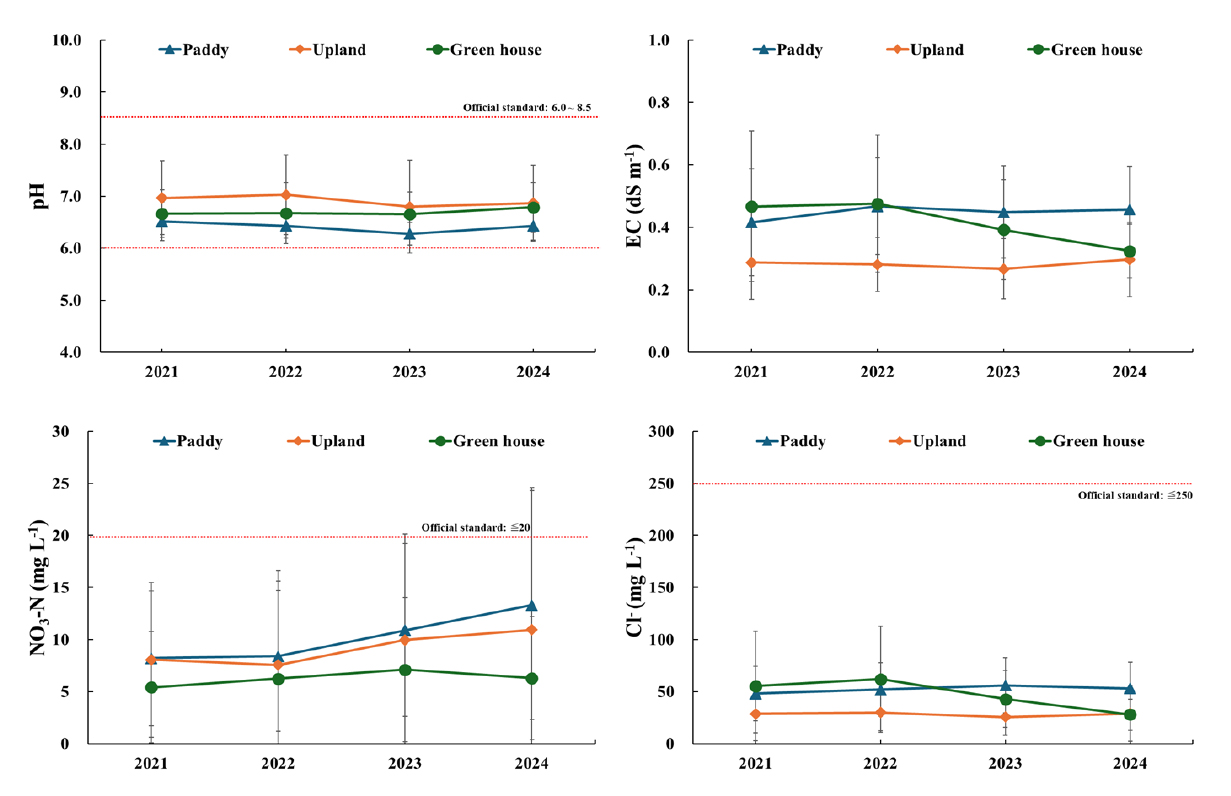
-
Short communication
- CO2 sequestration potential over 100 years of cattle manure biochar in soil as affected by different feedstocks and pyrolysis temperatures
- Kyung-Hwa Han, Seung-Beom Lee, Ye-rim Oh, Eun-su Song, Seok-In Yun, Jin-Hyeob Kwak
- Cattle manure, containing lignocellulosic biomass such as sawdust, rice straw, and rice husk as bedding materials, is rich in organic matter and …
- Cattle manure, containing lignocellulosic biomass such as sawdust, rice straw, and rice husk as bedding materials, is rich in organic matter and serves as a promising feedstock for biochar for carbon dioxide removal (CDR). However, the characteristics of manure-based biochar vary depending on feedstock composition, composting maturity, and pyrolysis temperature. This study evaluated the properties of cattle manure biochar (CMB) and 100-year carbon sequestration potential of CMB under different process conditions such as composting maturity (fresh and composted), mixing lignocellulosic biomass (sawdust, rice straw, and rice husk) and pyrolysis temperature (400°C, 500°C, and 600°C). CMB produced showed organic carbon contents above 30% for all process conditions. However, only the composted manure pyrolyzed at 400°C achieved an H/Corg molar ratio ≤0.7, a key criterion of international biochar certification as a CDR. Pyrolysis at ≥500°C satisfied this requirement regardless of feedstock types. The potential carbon sequestration of CMB was found to range from 0.68 to 1.67 tCO2-eq per ton of dry biochar, decreasing by approximately 1% for each 1 °C increase in soil temperature under global warming scenario. CMB mixed with lignocellulosic biomass showed higher potential carbon sequestration compared to that without lignocellulosic biomass. At a pyrolysis temperature of 400°C, the composted manure demonstrated a higher potential of carbon sequestration than fresh manure. However, this difference became negligible when the pyrolysis temperature was at 500°C or higher. Therefore, this study suggested that CMB produced at pyrolysis temperatures ≥500 °C could meet an H/Corg molar ratio ≤0.7, with its carbon sequestration potential increasing through the mixing of lignocellulosic biomass such as sawdust, rice straw, and rice husk. Carbon sequestration potential of cattle manure biochar (CMB) as affected by CM composting stage, mixing lignocellulosic biomass (LB) types, and pyrolysis temperatures. - COLLAPSE
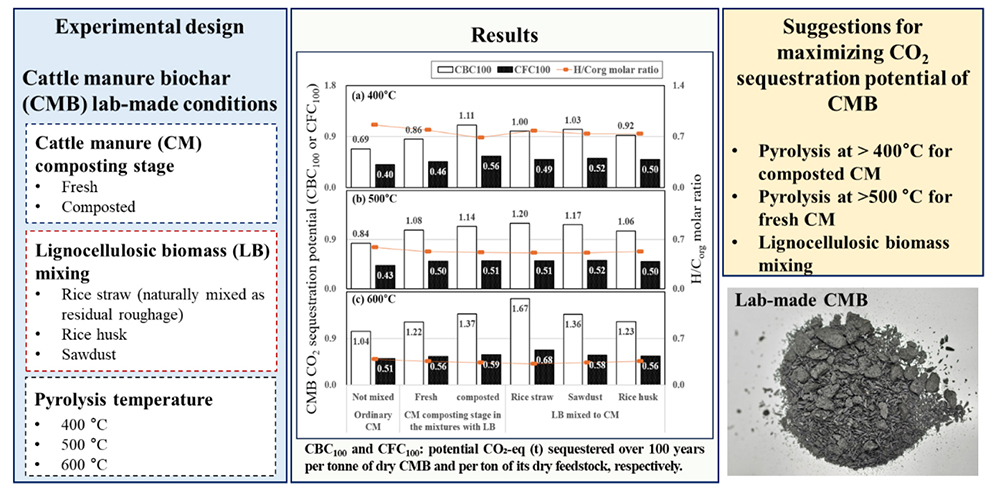
-
Short communication
- Trends in the chemical properties of orchard soils in Gyeong-buk province from 2002 to 2022
- Hye-Rin Jeong, Jong-Hee Shin, Yeon-Gyu Jeong, Jung-Gi Ryu
- Gyeong-buk province is a major fruit-producing region in comprising approximately 30% of the national orchard area. Given the perennial fruit trees, initial …
- Gyeong-buk province is a major fruit-producing region in comprising approximately 30% of the national orchard area. Given the perennial fruit trees, initial soil management is critical. This study analyzed the chemical properties of topsoil and subsoil from 300 orchard sites in Gyeongbuk over a 20-year period (2002 - 2022) at 4-year intervals. The results showed that soil pH increased from an average of 5.7 in 2002 to 6.4 in 2018, followed by a slight decline to 6.2 in 2022. Electrical conductivity (EC) remained below 1 - 2 dS m-1 at more than 90% of the sites, indicating minimal risk of salt accumulation. Soil organic matter content fluctuated between 24.6 and 37.3 g kg-1 across the sampling years. Available P2O5 concentration increased from 559 mg kg-1 in 2002 to 746 mg kg-1 in 2006, then remained relatively stable between 2010 (562 mg kg-1) and 2018 (591 mg kg-1), before showing a significant increase to 809.6 mg kg-1 in 2022, suggesting intensified phosphorus fertilization in recent years. Exchangeable Ca showed an increasing trend from 5.4 cmolc kg-1 in 2002 to 8.8 cmolc kg-1 in 2022, while exchangeable Mg also exhibited an increasing trend from 1.52 cmolc kg-1 in 2002 to 2.39 cmolc kg-1 in 2022, both attributed to continuous lime and dolomite applications for pH management. The subsoil exhibited similar trends to the topsoil in most parameters. This study provides fundamental data for orchard research and highlights the necessity of ongoing soil monitoring and nutrient management to ensure sustainable fruit production. Proportional distribution of chemical properties in orchard topsoil from 2002 to 2022 (n = 300). - COLLAPSE

Journal Informaiton
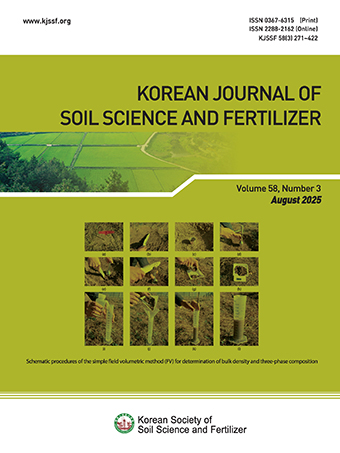 Korean Journal of Soil Science and Fertilizer
Korean Journal of Soil Science and Fertilizer
Journal Informaiton
Journal Informaiton - close
 Korean Journal of Soil Science and Fertilizer
Korean Journal of Soil Science and Fertilizer
